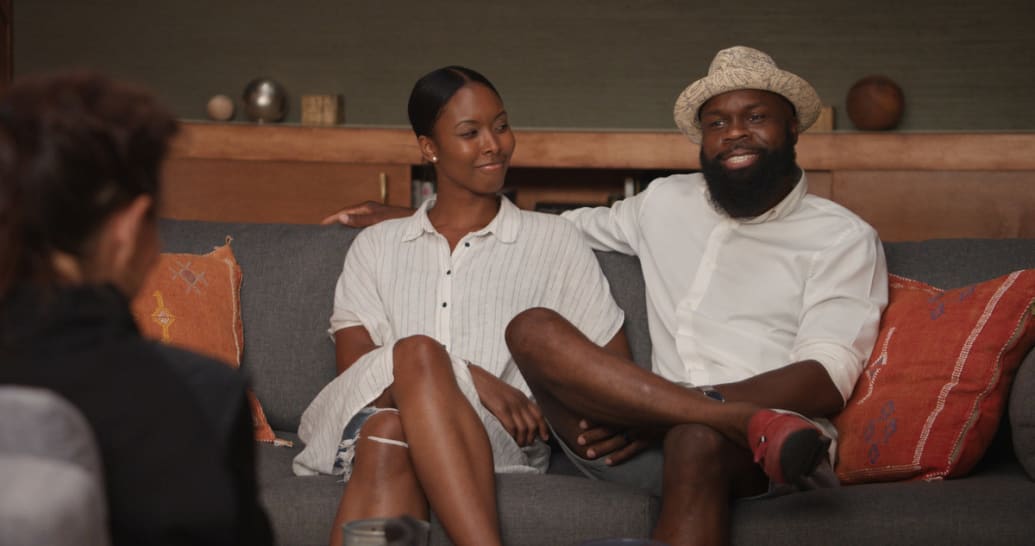Becoming a couples therapist requires insight and patience. But it also requires a willingness to empathize with individuals who are often at breaking point, unable (or unwilling) to investigate the root causes of their problems. along Couple TherapyIn the first three seasons of Orna Guralnik, she displayed all these traits along with humility, toughness, sense of humor and loyalty. So when she reveals that I’m “not the right therapist” for a couple of clients at the start of the new half-season, it’s the sudden promise that Showtime’s reality series (airing April 28) will go knee-deep in irresolvable conflict.
It’s also, of course, a mockery aimed at enticing viewers to stick around and guess which one it is. Couple TherapyThe four stories of ‘ led to such a statement. This is not easy to spot at first, as all of Guralnik’s recent patients are dealing with major issues that may or may not be corrected. like A&E’s InterveneShowtime’s overlooked hit is a no-flash event that immerses itself in real-life struggles. Each half-hour episode gets up close and personal with partners in the midst of the crisis to examine how these disasters came to be and the unsettling effort required to overcome them.
This premise is fully supported because its core issues are interrelated and moreover – it is handled by Guralnik and the series – with honesty, pragmatism and minimal narrative manipulation. The success or failure of couples can be the dramatic hook of judgment, but what is truly gripping is the image of unhappy people trying to find a way to mend the fundamental bonds that have been strained for whatever reason.
There’s just too much clutter to be found Couple Therapy, especially in the dynamics of couples. The season begins with Brock and Kristi, whose 15-year marriage has been upended by two main factors: First, Kristi’s (and later Brock’s) decision to leave the Mormon Church where she grew up; and secondly, Kristi’s decision to cheat on Brock – who is predisposed to an open relationship as a way of exploring their new post-Mormon identities – with one-man Brock asked her not to be with him.
Kristi’s anger at her “abusive” religious upbringing and community is evident in her friction with Brock; As they both struggle to reconcile their desire for commitment and freedom, they simultaneously forgive each other for their past crimes. Theirs is exacerbated by a stew of bitterness, regret, and fear and, as so often with Guralnik’s patients, a trust-shattering infidelity.
Infidelity is at the center of all three. Couple TherapyThe four stories of ‘s turn out to be the most common source of relationship breakdown. Erica and Sean disagree over Sean’s prostitution, which he claims was provoked by his wife’s insinuations that “going out” is okay (he denies the idea). But the fact that Sean is a two-stroke is somewhat of a secondary hurdle for the duo; His emotional distance, his habit of blaming Erica, and the consequent reluctance to take a long, careful look at himself, are more urgent. Guralnik believes his job as a psychoanalyst is to make people think, “What about me, not them,” and Sean strikingly illustrates the potential challenges of this task.
Couple Therapy This season also features a couple dealing with polygamy, a unique challenge the show has explored before. Nadine claims this is the paradigm they “need” in the first place; Apparently, this prerequisite is wrapped up in the childhood traumas of both he and his partner, Christine. It’s also a symptom of something that will be obvious to most, if not Nadine, and Christine viewers: wanting other people (even in the context of rediscovering the monogamous status quo) usually doesn’t want to be with you. It is complicated by their simultaneous efforts to understand their own (gay, independent, alienated from family) identities, a dynamic seen in
in this season Couple Therapy, only Joe and Natasha remained loyal to each other; Their dilemma is related to Natasha’s lack of close attention. Still, they are similar to Guralnik’s other patients in that much of their tension can be traced back to previous home and relationship issues; For them, like others, healing is possible only through open communication about themselves and each other.

In this context, Couple Therapy It remains a snapshot of introspection, dialogue and thought as the pillars on which successful relationships are built and the best available tools for repairing shattered fences. Of course, if those fences can be repaired – not everyone on this show looks cut out for the long haul, and this portrayal of blindness (whether intentional or not) is also part of the show’s revealing power.
The most exhilarating moments are when a breakthrough is made, either by Guralnik’s clever questions (which encourages patients to explore the basis of their feelings) or by partner self-reflection. These examples are Couple Therapyshows the value that people can derive from psychoanalysis. That said, Showtime’s series doesn’t pretend to have solutions to everyone’s dilemmas, and scenes where people authentically fight—sometimes in decidedly hostile and brutal ways—can be equally illuminating.
Guralnik’s peer advisory council on these cases and his own clinical advisor, Dr. It was taken inconspicuously and interspersed with her conversations with Virginia Goldner. Couple Therapy It provides an aesthetically calm, soothing environment. Here, both war and rehabilitation can take place. Of course, there are occasional stagnations in his action; Not everyone is cute (or deserving of a season’s attention), and not every issue is as meaningful as it might seem at first. This season, Guralnik’s Israeli heritage and Christine’s Palestinian history offer a less than compelling angle. Yet this series ties together more than it misses, and the fact that its plots don’t usually end where they begin – or where viewers likely expect – is testament to its serious commitment to therapeutic work.